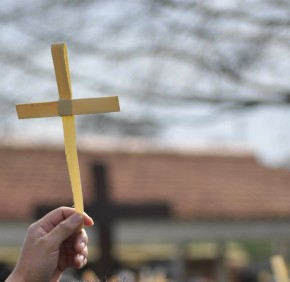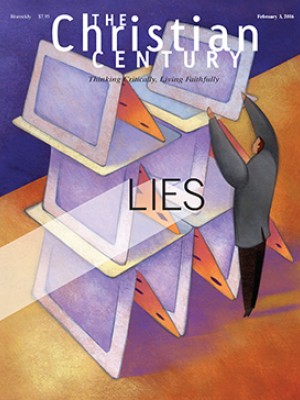Burying William: Funeral for a gang victim

I didn’t start my day thinking about gang killings. I had been drinking coffee, checking e-mail, juggling schedules, and preparing for Holy Week services. Then Antonio and José showed up. I didn’t know Antonio—he was one of many “assistance seekers” who drop by the church office—but I recognized José from Lunch for the Soul, our weekly outreach lunch to the day laborer population of Herndon, Virginia. For nine years we’ve served large crowds on frigid January days and an intimate bunch of 20 or so when landscaping jobs are easy to come by.
Antonio was fidgety, checking his phone. I found out why. He showed me a crumpled picture of his nephew William, who’d been killed by a gang the week before, his body dumped in a nearby creek bed in Hiddenbrook, a neighborhood where the bridge-playing ladies of our church drink tea and the only known villain is an unpredictable homeowners association.
Read our latest issue or browse back issues.
Antonio asked that we have a funeral for William at the church on Palm Sunday, the day we celebrate Jesus being called by name before adoring crowds while his enemies bide their time.
I stared into the eyes of William, a 20-year-old boy who had apparently been witness to a gang killing in El Salvador the year before. In order to save his life, Antonio had paid a coyote to have William smuggled into the States. “But I couldn’t keep him safe. They found him here,” he said, weeping. Antonio had placed cardboard boxes around town with William’s picture attached, hoping to raise the $9,500 it would cost to ship his body home to El Salvador. This was three times more than it cost to get him here. The difference in these transactions made my heart scream.
Then Antonio told me that he was neither sleeping nor eating because the gang was threatening him as well. I had rarely been afraid as a pastor in the leafy suburb of Herndon. Sure, there were the standard butterflies before delivering an edgy sermon or the day when a mentally ill or intoxicated person had acted out in the building. But nothing like this.
After Antonio left, I phoned the moderator of the deacons, who happened to be a Fairfax County police officer. I told her about William and the plans for his funeral. We touched bases about reception food and setup, but then I stopped her and asked in an embarrassed whisper, “Maybe I watch too much TV, but do you think this is a good idea?” And she responded, “Of course it is. We’re their church. And in the face of the worst evil the world has to offer, we get to say, ‘Love wins.’”
The funeral day arrived. The deacons put out a beautiful spread, with egg salad and chocolate chip cookies. Then the Salvadoran community arrived, and the women tucked their pupusas next to the lemon bars donated by families in the Hiddenbrook neighborhood. Everyone helped arrange chairs and put flowers in vases. It was liturgy, the work of the people.
The sanctuary filled with people, their waves of raw grief crashing over a modest coffin that held William. I would say grown men wept, but they were babies, barely 20 years old themselves. Their anger was hot.
I am not usually one for open caskets, but there was no interest in closure in the room—not yet. The casket stayed open during the entire service, parked on a red carpet flecked with bits of palm branches from the Palm Sunday service earlier that day. There we all were, a Palm Sunday crowd with Good Friday grief, talking about Easter hope.
The day is still vivid in my mind. What is it about the experience that won’t let me go? I think it’s that we had a chance as a church not just to talk about Holy Week but to live it out, to feel it in our bodies, our veins pumping with adrenaline and our backbones bracing with what felt as much like craziness as courage. The breaking of tortillas hummed with sacramental power. And when the Salvadoran community said William’s name aloud, insisting that he was a beloved child of God, it felt baptismal too. We witnessed a re-membering, a putting back together of something that should not have been broken. It was the church being the body of Christ.
In John’s Gospel, Mary Magdalene searched for the body of Jesus in a cemetery while it was still dark—which is as crazy as it is courageous. And when she finally encountered the risen Christ, he looked to her like a landscaper, a day laborer, until the moment when he said her name out loud: “Mary.” Her heart racing, she made the first Easter profession: “My Lord!”
Mary would not have been tarrying in that garden alone, walking and talking with Jesus, if she hadn’t been with him many times before.
William’s funeral would probably not have happened at our church without a hundred or so prior moments. It needed that moment at a session meeting when church leaders voted to start Lunch for the Soul instead of backing away. It needed that moment when huddled volunteers decided not to cancel Lunch for the Soul when it fell on Christmas Eve, but to use that banner day to draw in more people from the community. It needed lots of moments when someone decided to stay in the conversation, inquiring about another person’s life, sharing his or her own struggles, learning names and how to love the other person, instead of jumping up from the table to help clean up or duck out.
Those moments became building blocks of trust in God, an Emmaus Road to our own recognition of Christ. Little by little those moments worked their way into us, into our flesh and bone. Almost without noticing, we wound up with stronger backbones and softer hearts.
The Monday after Easter, Antonio called me up. This time his tears and mine were tears of gratitude for the Holy Week that God had led us through.






